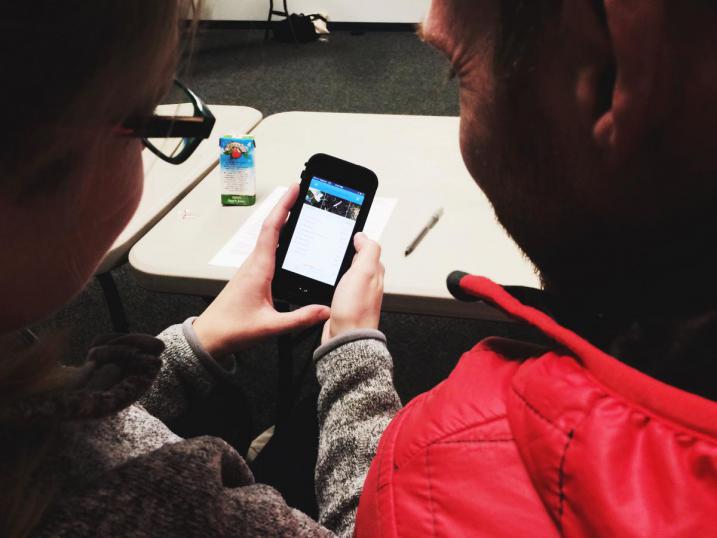New Research Shows Place Matters in Citizen Science

Over the last quarter century, UNH Cooperative Extension staff have worked with thousands of natural resource volunteers - in stewardship efforts like those in the NH Coverts Project, or in citizen science, like those in the Lakes Lay Monitoring Program. Their experience suggested that many volunteers don't draw a big distinction between volunteering for a stewardship project or volunteering for an environmental research project. It's all volunteering for nature, and they are interested in both. In fact, volunteers involved in research may be inspired to get involved in community action and stewardship, or vice-versa.
When UNH Extension launched Nature Groupie our mission included mobilizing volunteers for both environmental stewardship and environmental research. In practice, that meant involving partners and including volunteer opportunities and stories from both the land management community and the community of citizen science. As the Network mobilizes volunteers, we promote both stewardship and citizen science on our website.
Among professionals, University researchers, and agencies, however, the gap between science and action may be wider, with research taking place in one sphere and action, such as policy making, resource planning, or stewardship, taking place in another. But with increasing excitement about citizen science everywhere you look (Citizen Science Association, or Google "citizen science" for 17+ million results), we started to consider why and how citizen science and stewardship can or should be connected.
To that end, Malin Clyde, UNH Extension Specialist and Project Manager for the Stewardship Network: New England, worked over the last year with a team of co-authors on a new paper to be published in Biological Conservation, "Leveraging the power of place in citizen science for effective conservation decision making," available for free online now. The international team who wrote the article first met each other at the inaugural conference for the Citizen Science Association in 2015.
"After meeting some really smart people at the conference (my co-authors!), I joined the writing team because I believed, through my experience with volunteers and the citizen science hub at the Stewardship Network: New England, that there is something powerful about citizen science that taps into people's love for a particular place," says Clyde. She observed effective citizen science programs based in New England - like the Ashuelot Valley Environmental Observatory (AVEO) in New Hampshire - with highly dedicated volunteers who participate in research projects with varied topics (monitoring nighthawks, mapping vernal pools, etc.), based in a multi-town region of Southwestern NH. "AVEO focuses strongly on place, and less on a particular species or issue, with great results: strong volunteer recruitment, good volunteer retention, strong community support, expanded science capacity." The research team would assess how different programs capitalize on this sense of place, and would create a new way of looking at citizen science programs: how do programs emphasize a sense of place, and to what effect?
Clyde also observed that natural resource volunteers easily made the connection between studying a problem and taking action. "When we train volunteers to map a problem - say invasive plants or marine debris - they always quickly move to asking how to solve the problem they are assessing." She and the other researchers saw a potential link between citizen science, a sense of place, and programs' connection to community decision-making and action.

The new paper starts with this observation: "Many citizen science projects are place-based - built on in-person participation and motivated by local conservation. When done thoughtfully, this approach to citizen science can transform humans and their environment. Despite such possibilities, many projects struggle to meet decision-maker needs, generate useful data to inform decisions, and improve social-ecological resilience." Drawing from examples and data from three different citizen science hubs (Earthwatch, and CitSci.org, and Nature Groupie), the team's analysis showed that programs that leverage the power of place increase the use of their citizen science data in conservation decision making such as stewardship, policy, and resource management.
Based on this finding, the paper also offers recommendations for ways to improve citizen science to better take advantage of the power of place and inform action. These include developing place-based networks like Nature Groupie, and making sure citizen science data are available, well-documented, and geo-referenced so that people - in a certain place - can access them easily.
Lastly, added fun for citizen science groups working in New England: you just might find a reference to your program in the paper's narrative!
See other posts about this research by co-authors:
- Home is Where the Citizen Science Is - Greg Newman, CitSci.org & Natural Resource Ecology Laboratory, CO State University
- Leveraging the Power of Place in Citizen Science - New Paper - Po Ve Sham Blog, Muki Hakley
- Citizen Science Place and Conservation - John Gallo, Senior Scientist,Conservation Biology Institute
Partial support for this research provided by NH EPSCoR and the National Science Foundation's Research Infrastructure Improvement Award #11A-1330641.